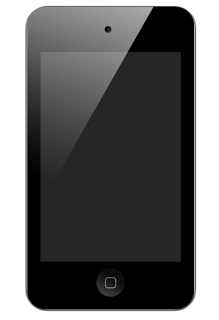First generation
| The first generation iPod Touch was launched on September 5, 2007, at an event called The Beat Goes On. First iPod with Wi-Fi and a Multi-Touch interface. Features Safari web browser and wireless access to the iTunes Store and YouTube. 32 GB and 16 GB versions later added (32 GB in Feb 2008). iPhone OS 2.0 and App Store access require an upgrade fee. iOS 4.0 and later updates of iOS 4.x are no longer supported due to the outdated hardware. |
Second generation
| The second generation iPod Touch featured a new tapered chrome back with Nike+ functionality, volume buttons, and built-in speaker added, It was unveiled on September 9, 2008, at the "Let's Rock" keynote presentation. iPhone OS 2.0 and App Store access standard. Bluetooth support added but not made active until iPhone OS 3.0, which requires an upgrade fee. Support for external microphone and remote added. The 8 GB model was re-introduced alongside the 3rd generation iPod Touch in September 2009, and included the newer iPhone OS 3.1. iOS 4 was released for free for second generation iPod Touch models June 21, 2010, but included a limited selection of features. Future iOS software updates no longer supported (As of iOS 4.2.1). The 2nd generation also comes with the chrome frame seen on the iPhone 3G, making the two almost identical when viewed from the front. However, there are some notable differences, as there is no speaker above the screen, no silent/ringer switch, the back is metal, and the sleep/wake button is on the other side. The 2nd generation also supports audio input when a headphone or earphone with microphone capabilities is plugged into the audio output (headphone) jack. The iPod Touch 2.0 Software Update supports WPA2 Enterprise with 802.1X authentication. The iPhone OS 3.0 update unlocked Bluetooth capability on the 2nd generation iPod Touch, as the included Wi-Fi chip (Broadcom BCM4325) has Bluetooth support. The 2nd generation iPod Touch is said to have a yellower cast/tint to the display, as compared to the iPhone or the original iPod Touch. The applications processor inside the 2nd generation iPod Touch runs slightly faster than the processor inside the iPhone 3G, but slower than the iPhone 3GS. The first generation iPod Touch works with all "Made for iPod" peripherals, but certain changes that Apple made to the 2nd generation iPod Touch prevent some existing peripherals from recharging the updated player. The Google Street View feature added on iPhone firmware version 2.2 is absent from the same version of firmware released on the iPod Touch, but is found in the 3.0 update. The 2nd and 3rd generation iPod Touch can be updated to iOS 4.x for free, but cannot take advantage of features using the iPhone's camera or GPS receiver. The 2nd generation iPod Touch is further unable to take advantage of iOS 4's multitasking and home screen background customization features, unless the firmware is modified (through jailbreaking), and cannot be upgraded beyond iOS version 4.2.1. Later updates of iOS beyond 4.2.1 are no longer supported due to the outdated hardware. The iPod Touch (2nd generation) is model A1288. |
Third generation
| The 32 GB and 64 GB models were updated to include the upgraded RAM, CPU and GPU internals from the iPhone 3GS; they include Voice Control support, VoiceOver, included iPhone OS version 3.x, and bundled remote earphones with microphone. The 3rd generation iPod Touch with iPhone OS 3.1 was announced and subsequently released on September 9, 2009. Apple's published technical specifications for the 3rd generation iPod Touch only include references to the 32 GB and 64 GB models. Following the introduction of the 3rd generation iPod Touch, Apple also continued offering the 2nd generation 8 GB version, upgraded to the same iPhone OS version as the new 3rd generation devices. The iPod Touch (3rd generation) is model A1318. Apple as well sold many refurbished iPod Touch 2nd generation models with the 3rd generation software effectively making them a 3rd generation unit. These can be identified by software version 4.3.5. |
Fourth generation
| Apple unveiled the 4th generation iPod Touch on September 1, 2010. It features a front-facing camera for FaceTime, the iPhone 4's Retina display without an IPS screen, support for recording 720p video and 960 x 720 still photos via a back camera, Apple's A4 chip, a built-in microphone, and a 3-axis gyroscope. For the appearance note also that the blank display has a significantly darker and more glossy tint than the previous models, as the higher pixel density absorbs a wider spectrum, darkening the reflection. On October 12, 2011, the iPod Touch 4th-generation began shipping with iOS 5.0 pre-installed for PC-free activation. Also, an additional color option, white, was made available. |




No comments:
Post a Comment